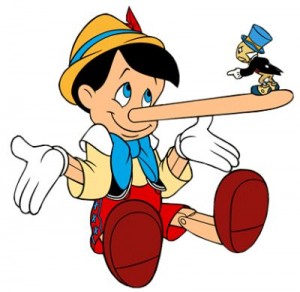Quote:
“A lie can run round the world before the truth has got its boots on.”
Terry Pratchett
Or then again, maybe it was:
“A lie gets half way around the world before the truth has a chance to get its pants on.”
Winston Churchill
Okay, possibly it was:
“A lie can travel halfway ’round the world while the truth is putting on it’s shoes.”
Mark Twain
But the earliest reference I find is:
“A lie can be halfway round the world before the truth has got its boots on.”
James Callaghan
British Labour Party Leader, who attributed the original quote to prominent 19th century Baptist preacher C.H.Spurgeon (1834 – 1892)
Who can say if he borrowed it from some one, and that was before the prevalence of the internet. I guess now it could be re-written once more that:
“A lie can travel across the web before the truth has its operating system booted up!”
Henry Paterson (1964 – not yet, but I am a little tired this morning)
According to Wikipedia, Truth is defined as: In accord with fact or reality, or fidelity to an original or to a standard or ideal. However there is something to be said for the words of Austro-Hungarian Economist and Philosopher Friedrich Hayek who said:
“It is only because the majority opinion will always be opposed by some that our knowledge and understanding progress.”
And the truth about science is that while reality is persistent, our understanding of it is highly mutable and the human brain is always seeking mental anchors. We are resistant to change. (Be sure to read Kevin Brian Carroll’s blog conversation on this topic.) Of course in keeping with the above statement, some will always be opposed to the idea of mental anchors and try to, how shall we say? Force changes that may not be necessary or true? To forestall the comments (it wont work but I am going to say it anyway): This applies equally to us here who approach the unexplained stories we bring you with a healthy dose of scepticism.
I recently encountered the letter below regarding a comparison of how two of the most famous and widely known cases of Crypto-Zoology have been treated in the press and by popular opinion:
To the Editor:
In “Nessie Hoax Redux” (March 1996), Joe Nickell ignores the greater issue raised in my November 1995 article in Fate magazine — the unacceptable double standard applied during debates over cryptozoology.
Self-proclaimed conspirator Christian Spurling waited more than a half century before claiming to have helped stepfather M. A. Wetherell use a modified toy submarine to fake a “Nessie” image in 1934; he never presented a shred of corroborating evidence to support his allegations; he was suspiciously vague when asked about a second, lesser-known photo; and he even failed to identify the bay where the hoax supposedly took place.
What if Spurling had claimed to have really seen and photographed a large unknown animal? Would this level of “proof” still be acceptable? Of course not. But because he was debunking Lt. Col. R. Kenneth Wilson’s famous photo the rules are very loose indeed. His mere say-so is okay. Ronald Binns excuses lapses and contradictions in Spurling’s story by suggesting that he was an old man when he finally gave his account and “maybe just confused. (Of course, scientific studies have shown that it is short term, not long term, memory that typically fades with age.) Worse still, Binns and other apologists are ready to blithely modify Spurling’s account whenever problems arise — “Maybe he was right about how the model was made but wrong about the dimensions,” Binns hypothesizes — until what should be consistent, definitive testimony becomes conveniently malleable.
Spurling’s supporters allow no such excuses for Col. Wilson, who denied on occasion late in life that he ever photographed a Loch Ness monster; not allowing that this was likely his way of getting rid of pesky reporters. (In fact, Wilson stuck by his original story when interviewed in the 1960s by Member of Parliament Sir David James.)
Nickell calls Binns’ The Loch Ness Mystery Solved “the definitive skeptical book on the subject.” That honor should go to Steuart Campbell’s The Loch Ness Monster (Aquarian Press, 1986). Campbell is the best and most thorough of the Nessie debunkers — therefore it is highly significant that he too rejects Spurling’s toy submarine story. In a letter to the CSICOP magazine Skeptical Inquirer (“Nessie ‘model’ explanation suspect,” March/April 1995), Campbell notes: “In their eagerness to undermine paranormal claims, writers in SI exhibit a tendency to accept any normal explanation, whether or not there is adequate evidence.”
How true. There have certainly been many hoaxes at Loch Ness, and we must all remain vigilant against bunkum. But rationality demands that we have one stringent standard of evidence for proponent and debunker alike, and that we never abandon a healthy skepticism to embrace stories as flimsy and unsubstantiated as the one told by the late Christian Spurling.
Sincerely,
Richard D. Smith
Now I have several other problems with the possible reality of Nessie, but admit my guilt of taking as gospel the “evidence” of the death bed confession that the Surgeon’s photo was faked. I have a few problems with the photo still and cannot say my mind has been changed about its reality, but I can at least refrain from promoting it as a hoax based upon one man’s unsubstantiated word.
“Whenever a theory appears to you as the only possible one, take this as a sign that you have neither understood the theory nor the problem which it was intended to solve.”
Karl Popper
To scold, chastise or otherwise punish me (after choosing an appropriate safe word)





